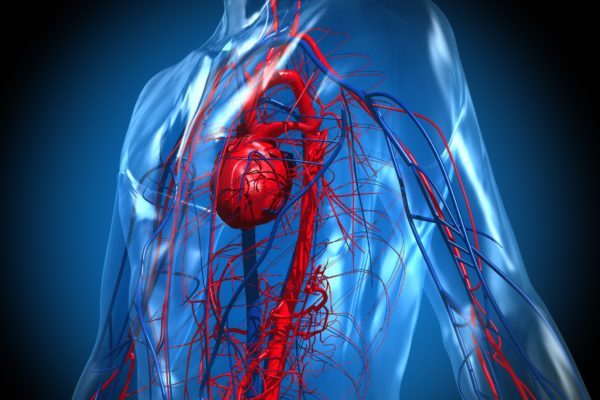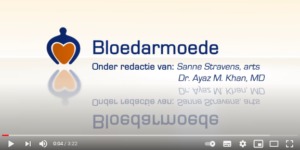Clinical picture
Anaemia is a decrease in the total amount of red blood cells (RBCs) or haemoglobin in the blood, or a lowered ability of the blood to carry oxygen. The word anaemia is derived from the Greek αναιμία (anaemia), meaning without blood or bloodlessness. Anaemia is usually a sign of a disease process rather than a disease itself. There are more than 400 types of anaemia, which are divided into three groups:
- Anaemia caused by blood loss
- Anaemia caused by decreased or faulty red blood cell production
- Anaemia caused by destruction of red blood cells
Red blood cells are made in the bone marrow and released into the blood stream when matured. The haemoglobin molecule is a complex iron-rich protein inside red blood cells, responsible for oxygen and carbon dioxide transport throughout the body. Haemoglobin gives blood the red color. To produce haemoglobin and red blood cells, the body needs iron, vitamin B-12, folate and other nutrients. When there is a shortage of one of the substances, no haemoglobin can be produced. This may result in anaemia.
In general, there are three major types of anaemia, classified according to the size of the red blood cells and their hemoglobin levels:
- Microcytic anemia, when the red blood cells are smaller than normal. The major causes of this type are iron deficiency (low level iron) anaemia and thalassaemia (inherited disorders of haemoglobin).
- Normocytic anaemia, when the red blood cells size are normal in size but low in number. Such as anaemia that accompanies chronic disease or anaemia related to kidney disease.
- Macrocytic anaemia, when red blood cells are larger than normal. Major causes of this type are pernicious anaemia and anaemia related to alcoholism.
Symptoms
Because a low red blood cell count decreases oxygen delivery to every tissue in the body, anaemia can cause a variety of signs and symptoms. It can also worsen the symptoms of almost any other underlying medical condition. If anaemia is mild, it may not cause any symptoms. If anaemia is slowly ongoing (chronic), the body may adapt and compensate for the change. In this case there may not be any symptoms until the anaemia becomes more severe.
Symptoms of anemia may include the following:
- weakness
- shortness of breath
- dizziness
- fast or irregular heartbeat
- pounding or “whooshing” in your ears
- headache
- cold hands or feet, leg cramps
- pale or yellow skin
- chest pain
- insomnia
Cause
The causes of anaemia may be classified as impaired red blood cell (RBC) production, increased RBC destruction (haemolytic anaemias), blood loss and fluid overload (hypervolemia). Main causes are:
- Sudden (acute) blood loss caused by surgery, accident or childbirth.
- Prolonged (chronic) blood loss due to heavy menstrual periods, inflammation or gastrointestinal tract tumors.
- Impaired production of red blood cells in the bone marrow. Seen in aplastic anemia, and hereditary disorders such as thalassemia, spherocytosis and sickle cell anemia.
- Deficiency in nutrients (iron, folic acid, vitamin B12) needed for red blood cell production.
- Impaired production of red blood cells caused by replacement of bone marrow by other materials, such as malignant tumors or granulomas. This can occur in leukemia, myelodysplastic syndrome, lymphomas (Hodgkin or Non-Hodgkin’s lymphoma), multiple myeloma or myeloproliferative disorders.
- Impaired production of red blood cells caused by chemicals (such as benzene), toxins or radiation.
- Increased destruction of red blood cells (haemolytic anemia) in which they become dysfunctional. Some forms of hemolytic anemia can be hereditary with constant destruction and rapid reproduction of red blood cells, as occurs in hereditary spherocytosis, hereditary elliptocytosis, and glucose-6-phosphate dehydrogenase or G6GD deficiency.
Hereditary and non-hereditary forms of haemolytic anaemia
In haemolytic anemia red blood cells are destroyed and removed from the bloodstream before their normal lifespan is over. This condition can be inherited or acquired. Treatment and outlook of haemolytic anaemia depend on the type and severeness. It can develop suddenly or slowly and symptoms can range from mild to severe.
Haemolytic anaemias may be classified according to the means of hemolysis, being either intrinsic (mostly hereditary) in cases where the cause is related to the red blood cell (RBC) itself, or extrinsic (acquired) in cases where factors external to the red blood cell dominate. Intrinsic effects may include problems with RBC proteins or oxidative stress handling. External factors include immune attack and microvascular angiopathies where red blood cells are mechanically damaged in circulation.
Hereditary hemolytic anemia can be due to:
- Defects of red blood cell membrane production (as in hereditary spherocytosis and hereditary elliptocytosis)
- Defects in hemoglobin production (as in thalassemia, sickle-cell disease and congenital dyserythropoietic anemia)
- Defective red cell metabolism (as in glucose-6-phosphate dehydrogenase deficiency and pyruvate kinase deficiency)
- Paroxysmal nocturnal hemoglobinuria (PNH), sometimes referred to as Marchiafava-Micheli syndrome, is a rare, acquired, potentially life-threatening disease of the blood characterized by complement-induced intravascular hemolytic anemia.
Acquired haemolytic anaemia may be caused by immune-mediated causes, drugs and other miscellaneous causes.
- Immune-mediated causes could include transient factors as in Mycoplasma pneumoniae infection or permanent factors as in autoimmune diseases, like autoimmune hemolytic anemia such as systemic lupus erythematosus, rheumatoid arthritis, Hodgkin’s lymphoma, and chronic lymphocytic leukemia).
- Spur cell hemolytic anemia
- Any of the causes of hypersplenism (increased activity of the spleen), such as portal hypertension.
- Acquired haemolytic anaemia is also encountered in burns and as a result of certain infections (e.g. malaria).
- Lead poisoning resulting from the environment causes non-immune haemolytic anaemia.
- Similarly, poisoning by arsine or stibine also causes haemolytic anaemia.
- Runners can suffer haemolytic anaemia due to footstrike haemolysis, owing to the destruction of red blood cells in feet at foot impact.
- Low-grade haemolytic anaemia occurs in 70% of prosthetic heart valve recipients, and severe haemolytic anaemia occurs in 3%.
Diagnosis
To diagnose anaemia the following tests might be included:
- Previous medical and family history
- Physical examination
- Blood tests:
- Complete blood count (CBC), which determines the number, size, volume, and haemoglobin content of red blood cells.
- Blood iron level and serum ferritin level, the total iron stores indicators.
- Levels of vitamin B12 and folate, vitamins necessary for red blood cell production.
- Special blood tests to detect rare causes of anaemia, such as an immune attack on the red blood cells, red blood cell fragility, and defects of enzymes, haemoglobin, and clotting.
- Reticulocyte count, bilirubin, and other blood and urine tests to determine how quickly blood cells are being made or if it concerns haemolytic anaemia.
- Microscopic examination of the size, shape, and colour of the red blood cells.
Blood tests will not only confirm the diagnosis of anaemia, but also help point to the underlying condition. For example, iron deficiency anaemia can result from chronic bleeding of ulcers, benign polyps in the colon, colon cancer, tumours or kidney problems.
More information about diagnosing anaemia can be found in the guideline Laboratoriumdiagnostiek Anemie (LESA) of the NHG.
Treatment
Medical treatment of anaemia varies widely and depends on the cause and the severity of anaemia. The aim of the treatment is to increase the amount of oxygen that the blood can carry. This is done through restoration of red blood cell volume or haemoglobin level. Because anaemia is usually the result of an underlying disease, it is always necessary to identify the cause.
A vitamin or iron deficit can be treated with the help of supplements or suitable diet. In other cases medications and treatments that correct the common underlying causes of anaemia may be helpful:
- Iron supplements may be taken during pregnancy and when iron levels are low. It is important to determine the cause of iron deficiency and treat it properly.
- Vitamin supplements may replace folate and vitamin B12 in people with poor eating habits. In people with pernicious anaemia who are unable to absorb sufficient amounts of vitamin B12, monthly injections of vitamin B12 are commonly used to replete the vitamin B 12 levels and correct the anaemia.
- Erythropoetin alfa is a medication that can be given as an injection to increase red blood cell production in people with kidney problems. The production of erythropoietin is reduced in people with advanced kidney disease, as described earlier.
- Stopping a medication that may be the cause of anaemia may also reverse anaemia after consultation with a physician.
- If alcohol is the cause of anaemia, then in addition to taking vitamins and maintaining adequate nutrition, alcohol consumption needs to be stopped.
- Blood transfusions should only be undertaken in cases of cardiovascular instability.
Additional information
Patient organisations
Related articles

Clinical picture

Symptoms

Cause

Diagnosis

Treatment

Links






